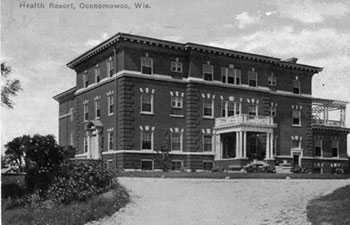Theresa Rogers understood the benefits of gardening in the healing process. The wife of Rogers’ founder, Mrs. Rogers created a magnificent garden which, in the 1920s, drew busloads of people to visit what is now Rogers Behavioral Health Hospital–Oconomowoc. Rogers was known throughout the Midwest for its beautiful landscaping and two miles of natural gardens.
 Mrs. Rogers planted a living legacy which endures today. However, it took the perseverance of Rita Nolte to return the gardens to their glory and set the stage for an even greater vision which continues to evolve.
Mrs. Rogers planted a living legacy which endures today. However, it took the perseverance of Rita Nolte to return the gardens to their glory and set the stage for an even greater vision which continues to evolve.
When Rita joined Rogers in the 1990s as a patient assistant, the gardens were dreadfully unkempt. She wanted our patients to have a serene view that could bring peace to their often chaotic health situations.
Moving Into Action
In 1990, Rita’s role was to monitor her patients’ emotions and assist in therapy. She would often look out the windows of the main hospital down into what was then called the kitchen garden, which was filled with raspberries, rhubarb and other produce grown in the era of Dr. and Mrs. Rogers.
But in 1990, the kitchen garden had grown wild. Rita was worried about what patients and visitors would think of the sight. “When patients are in distress, they don’t need more chaos,” she says. So, beginning in 1991, the then-patient assistant began volunteering two hours per day, two days per week pulling weeds with her own tools in what is known today as the center courtyard.
Finding Others Who Believed in the Mission
In 1992, Rita found two volunteers; she needed additional hands if big changes were ever going to be accomplished. “They did this all on their own time,” she says. “It was a real commitment by people who saw the spiritual nature of gardens, plant materials and how it could renew people,” she says.
Volunteers were given a free plant for every 2 hours of their time. “That particular practice is what I used throughout the rest of the restoration process,” she says, “If people helped, they went home with a plant.”
Rita took on another garden in 1993 located next to an old barn on the property, while still continuing to work on the center courtyard. By this time, Rita formed a sub-committee of volunteers and began planning a barn sale in September of that year to collect funds.
By 1994, Rita was forming a new dream and began collecting input for redesigning Rogers’ largest gardens—the Theresa Rogers Gardens. She formed a full committee to create an implementation process and in April, they held their first official meeting. By May, the center courtyard was complete and had a vegetable garden, grass center, flower bed and picnic tables for staff and patients to eat their lunches and enjoy the peaceful natural space. It was a total transformation from the weed-ridden patch Rita once looked at from the hospital’s window.

At the end of May, Rita spaded and weeded the front yard of the hospital. She planted flowers in two large empty concrete urns sitting at the hospital entrance, which were original to the grounds. Today, the urns, other original pieces and plants can be found in the Theresa Rogers Garden.
The Infancy of Horticultural Therapy at Rogers
In March 1995, Rita was approached by leaders of the adolescent residential program who found many teens enjoyed the outdoors and wanted to help Rita garden.
“Spending time in the environment was enjoyable for the patients,” she says. Adolescents wanted to help with everything from hauling brush to pulling weeds, all to enjoy the benefits of fresh air and planting.
Rita Takes her Cause to the Board
Rita made an appointment with the Rogers Behavioral Health Hospital Board in April 1995 as her funds from the barn sale were quickly dwindling and she needed additional help to continue restoring the gardens to the original splendor that Theresa Rogers created. She explained her philosophy to the board, as well as the healing and spiritual properties of the gardens, saying, “We have 56 acres of property, we have trees, we have lake frontage, we have small ponds, but we have rack and ruined gardens.”
To Rita’s surprise, the board awarded her a large contribution for the renovation, which greatly surpassed her initial goal. She used these funds to maintain the landscapes she had created and worked diligently with patients and volunteers to keep up with the gardens.
In 1999, Nolte was awarded an even larger donation from the board and finally had enough funds to begin carrying out her master plan for the Theresa Rogers Gardens, which included a traditional English style matching the heritage of Dr. and Mrs. Rogers. The design process began that year and was developed by Margaret Harvey, landscape architect of Milwaukee, Wisconsin, and Dorset, England.
Keeping the Gardens Traditional
Like Dr. and Mrs. Rogers, Rita has English heritage. In 2000, she traveled to England for an authentic experience of English culture and to study the traditional gardens for her work in Oconomowoc. “Sometimes, we had to find similar alternatives to the English plants because the climate is different in Wisconsin,” Rita says.
Realizing the extent of the work ahead of her, in 2000 Rita moved from her recently acquired position in the purchasing department into a solely gardening position. She worked four to six hours per day, five days per week from March until November on her life’s passion of transforming the gardens to their full potential, which was finally reached in 2001. “Early on as a child, I read hero stories and I really wanted to do something to make a difference in this world, and I truly didn’t know that this was it until it was done,” she says.
Working in the gardens wasn’t just smelling the roses. The biggest challenge Rita faced was getting water access in the gardens. Before a pump was installed in 2012, she and other volunteers had to haul hoses to the gardens.
 Rita’s Final Reflection
Rita’s Final Reflection
Volunteers and patients not only helped build the gardens, but many have experienced the healing properties of nature that Rita stands by. She says one patient told her, “Pulling these weeds is like pulling the trouble out of my life.”
Another patient made discoveries about her own perfectionisms by working in nature. Rita notes, “She learned some plants die no matter what you do, and that’s not failure, that’s just the natural life cycle of a plant,” says Rita. “You can do the best you can and things don’t always turn out. She knew the gardens were still beautiful even though they may have had a few weeds or dead flowers.”
Rita credits her passion and knowledge of gardening to the teachings of her mother, grandmothers and grandfather. Regardless of the amount of time and work she put into the gardens at Rogers Behavioral Health Hospital, she insists,
“The real story is the garden, I just happened to be in it and it was my privilege.”


